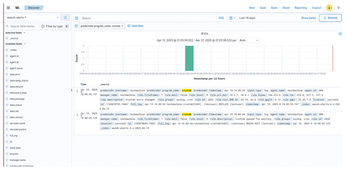Integrated security with Wazuh
Suricata
You can also integrate Wazuh with the Suricata IDS system [4]. Suricata can provide additional insights into your network's security with its network traffic inspection capabilities.
Install Suricata on the endpoint:
sudo add-apt-repository ppa:oisf/suricata-stable sudo apt-get update sudo apt-get install suricata -y sudo systemctl enable suricata.service
Modify Suricata settings in the /etc/suricata/suricata.yaml file and set the variables in Listing 4.
Listing 4
Suricata Variables
sudo nano /etc/suricata/suricata.yaml HOME_NET: "<Host_IP>" EXTERNAL_NET: "any" default-rule-path: /etc/suricata/rules rule-files: - "*.rules" # Global stats configuration stats: enabled: yes # Linux high speed capture support af-packet: - interface: enp0s3
Restart the Suricata service:
sudo systemctl restart suricata
Then add the following configuration to the /var/ossec/etc/ossec.conf file of the Wazuh agent:
<ossec_config> <localfile> <log_format>json</log_format> <location>/var/log/suricata/eve.json</location> </localfile> </ossec_config>
Restart the Wazuh agent on the endpoint:
sudo systemctl restart wazuh-agent Incident Response
The most important use of Wazuh is incident response. It is therefore important to know how to check and search for logs collected by agents. When you expand the list on the left side of the console, the Explore tab will appear. Select Discover to search for all collected alerts. The good thing is that you can search all these alerts using filters. For example, you can search only for high and critical severity alerts or alerts within a given time range (Figure 3).
You can also search for events related to a specific program. For a simple example, what if you need to find out if a crontab was run and edited somewhere? Click Add filter and fill in the values (Figures 4 and 5).
 Figure 5: Filtering for references to crontab lets this admin zero in on potentially nefarious activity.
Figure 5: Filtering for references to crontab lets this admin zero in on potentially nefarious activity.
Automation
Process automation is very useful and important in cybersecurity. Automatically blocking a user account, blocking an IP address, or restarting a machine is helpful in the daily work of an analyst.
To configure an active response, first check for the configuration file on the Wazuh server /var/ossec/etc/ossec.conf. This file should be added by default, but add one if it doesn't exist already.
The following code configures Wazuh to disable a user account:
<command>
<name>disable-account</name>
<executable>disable-account</executable>
<timeout_allowed>yes</timeout_allowed>
</command>Then add or modify the <active-response> rule in the configuration file:
<active-response> <disabled>no</disabled> <command>disable-account</command> <location>local</location> <level>7</level> <timeout>600</timeout> </active-response>
Use the <agent_id> tag to specify the ID of the Wazuh agent that must run the script regardless of where the event occurred. For example:
<location>defined-agent</location>
<agent_id>001</agent_id>Restart the Wazuh manager to apply all the changes:
sudo systemctl restart wazuh-manager
Conclusion
As you can see, a simple Wazuh server and agent configuration can help control the infrastructure. Of course, the sample configuration in this article is not a complete recipe for complete protection; in a real-world setting, you will need to implement queries and automate them. It is important to remember playbooks that will tell analysts how to react to a given alert and threat. Wazuh is certainly worthy of your consideration as you implement a security strategy for your network.
Infos
- Wazuh: https://github.com/wazuh
- TheHive: https://github.com/TheHive-Project/TheHive
- ClamAV: https://www.clamav.net/
- Suricata: https://suricata.io/
« Previous 1 2 3
Buy this article as PDF
(incl. VAT)
Buy Linux Magazine
Subscribe to our Linux Newsletters
Find Linux and Open Source Jobs
Subscribe to our ADMIN Newsletters
Support Our Work
Linux Magazine content is made possible with support from readers like you. Please consider contributing when you’ve found an article to be beneficial.

News
-
Debian Unleashes Debian Libre Live
Debian Libre Live keeps your machine free of proprietary software.
-
Valve Announces Pending Release of Steam Machine
Shout it to the heavens: Steam Machine, powered by Linux, is set to arrive in 2026.
-
Happy Birthday, ADMIN Magazine!
ADMIN is celebrating its 15th anniversary with issue #90.
-
Another Linux Malware Discovered
Russian hackers use Hyper-V to hide malware within Linux virtual machines.
-
TUXEDO Computers Announces a New InfinityBook
TUXEDO Computers is at it again with a new InfinityBook that will meet your professional and gaming needs.
-
SUSE Dives into the Agentic AI Pool
SUSE becomes the first open source company to adopt agentic AI with SUSE Enterprise Linux 16.
-
Linux Now Runs Most Windows Games
The latest data shows that nearly 90 percent of Windows games can be played on Linux.
-
Fedora 43 Has Finally Landed
The Fedora Linux developers have announced their latest release, Fedora 43.
-
KDE Unleashes Plasma 6.5
The Plasma 6.5 desktop environment is now available with new features, improvements, and the usual bug fixes.
-
Xubuntu Site Possibly Hacked
It appears that the Xubuntu site was hacked and briefly served up a malicious ZIP file from its download page.



